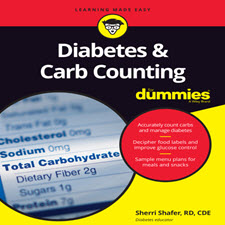Nutrition and Diet in Maternal Diabetes
ABSTRACT
Diabetes is a serious and growing disease with implications for health and development. More than 400 million people have diabetes . While the majority of cases consist of type 2 diabetes, hyperglycaemia and diabetes in pregnancy and their outcomes present a serious and increasing global challenge . Babies born to women with elevated blood glucose levels are at greater risk of adverse pregnancy outcomes including foetal abnormalities, macrosomia, obstructed labour, and hyperinsulinemia and hypoglycaemia at birth . Even with the mildest forms of hyperglycaemia in pregnancy (HIP), both mother and child are at increased risk of later development of type 2 diabetes, carrying on the diabetes epidemic through future generations . Estimating the global burden of HIP is a challenge because of the variety of methods and definitions used . However, the public health importance of HIP is high and understanding the direction of the epidemic and those most vulnerable is essential to beginning the important work of turning the tide on diabetes.
INTRODUCTION
Various national and international bodies have published a range of guidelines and recommendations on screening methods and diagnostic criteria for the screening and diagnosis of HIP. The condition was first known only as gestational diabetes mellitus (GDM) and was described for mothers developing hyperglycaemia during their pregnancies. The first diagnostic criterion was provided by O’Sullivan et al. in 1964 and was based on 3-h 100 g oral glucose tolerance test (OGTT) at 22 weeks gestation . The hyperglycaemia would inevitably resolve post-partum. The criterion was validated against the risk of future development of diabetes for the mothers and gained wide acceptance. At the time, developing type 2 diabetes in women of reproductive age was so rare as to be unconsidered in the development of a definition. In 1980, the World Health Organization (WHO) made the recommendation to use a 2-h 75 g OGTT for pregnant women to harmonise the diagnostic criteria with that used to diagnose diabetes and impaired glucose tolerance . Since the 2-h 75 g OGTT had been little investigated for use in pregnancy, various associations and national guideline panels stayed with the recommendations of the U.S. National Diabetes Data Group (NDDG) to use the O’Sullivan 3-h test .
چکیده
دیابت یک بیماری جدی و رو به رشد است که پیامدهای آن برای سلامت و توسعه است. بیش از 400 میلیون نفر دیابت دارند. در حالی که اکثر موارد شامل دیابت نوع 2، هیپرگلیسمی و دیابت در دوران بارداری و نتایج آنها یک چالش جدی و رو به افزایش جهانی است. نوزادان متولد شده در زنان با سطوح بالای قند خون، در معرض خطر بیشتر پیامدهای بارداری، از جمله اختلالات جنینی، ماکروزومی، کار زایمان، و هیپنوتیزم و هیپوگلیسمی در هنگام تولد هستند. حتی با خفیفترین انواع هیپرگلیسمی در دوران بارداری (HIP)، هر دو مادر و کودک در معرض خطر ابتلا به دیابت نوع 2 قرار دارند، که از طریق نسلهای آینده بیماری همه گیر دیابت را به خطر می اندازد. برآورد بار جهانی HIP چالشی است به دلیل انواع روش ها و تعاریف مورد استفاده. با این حال، اهمیت سلامت عمومی HIP بسیار بالا است و درک مسیر بیماری همه گیر و کسانی که بیشترین آسیب پذیر را برای شروع کار مهم برای تبدیل شدن به جریان انسولین در دیابت ضروری است.
مقدمه
سازمان های مختلف ملی و بین المللی مجموعه ای از دستورالعمل ها و توصیه های در مورد روش های غربالگری و معیارهای تشخیصی برای غربالگری و تشخیص HIP را منتشر کرده اند. این وضعیت در ابتدا تنها به عنوان دیابت بارداری شناخته شد (GDM) و برای مادرانی که در دوران بارداری مبتلا به هیپرگلیسمی بودند، توصیف شد. اولین معیار تشخیص توسط O’Sullivan و همکاران ارائه شده است. در سال 1964 و بر اساس آزمایش 3 ساعته 100 گرم تحمل گلوکز خوراکی (OGTT) در 22 هفته بارداری بود. هیپرگلیسمی ناگزیر پس از زایمان را حل می کند. این معیار در برابر خطر توسعه دیابت برای مادران تأیید و پذیرفته شد. در حال حاضر، در حال توسعه دیابت نوع 2 در زنان سن باروری تا اندازه ای در توسعه یک تعریف محسوب نمی شود. در سال 1980، سازمان بهداشت جهانی (WHO) توصیه کرده است که برای زنان باردار 75 گرم OGTT مصرف شود تا معیارهای تشخیصی را با آنچه که برای تشخیص دیابت و اختلال تحمل گلوکز استفاده می شود، هماهنگ کند. از آنجا که OGTT 2 تا 75 گرم برای استفاده در حاملگی کمی مورد بررسی قرار گرفت، انجمن های مختلف و پانل های راهنمایی ملی با توصیه های گروه داده های دیابت ملی آمریکا (NDDG) با استفاده از آزمون 3 ساعته O’Sullivan باقی ماندند.
Year: 2016
Publisher: SPRINGER
By : Rajkumar Rajendram , Victor R. Preedy,Vinood B. Pate
File Information: English Language/ 517 Page / size: 6.80 MB
سال : 1395
ناشر : SPRINGER
کاری از : Rajkumar Rajendram، ویکتور R. Preedy، Vinood B. مقررات
اطلاعات فایل : زبان انگلیسی / 517 صفحه / حجم : MB 6.80

![Nutrition.and.Diet.in.Maternal.Diabetes.[taliem.ir]](https://taliem.ir/wp-content/uploads/Nutrition.and_.Diet_.in_.Maternal.Diabetes.taliem.ir_.jpg)
![Crohn’s.Disease.and.Ulcerative.Colitis.From.[taliem.ir] Crohn's.Disease.and.Ulcerative.Colitis.From.[taliem.ir]](https://taliem.ir/wp-content/uploads/Crohns.Disease.and_.Ulcerative.Colitis.From_.taliem.ir_.jpg)
![Diabetes.and.Exercise.From.Pathophysiology.to.Clinical.Implementation.[taliem.ir] Diabetes.and.Exercise.From.Pathophysiology.to.Clinical.Implementation.[taliem.ir]](https://taliem.ir/wp-content/uploads/Diabetes.and_.Exercise.From_.Pathophysiology.to_.Clinical.Implementation.taliem.ir_.jpg)
![Nutrition.in.Lifestyle.Medicine.(Nutrition.and.Health).[taliem.ir] Nutrition.in.Lifestyle.Medicine.(Nutrition.and.Health).[taliem.ir]](https://taliem.ir/wp-content/uploads/Nutrition.in_.Lifestyle.Medicine.Nutrition.and_.Health.taliem.ir_.jpg)
![Nutrition.and.Health.in.a.Developing.[taliem.ir] Nutrition.and.Health.in.a.Developing.[taliem.ir]](https://taliem.ir/wp-content/uploads/Nutrition.and_.Health.in_.a.Developing.taliem.ir_.jpg)
![Diet.Nutrition.and.Fetal.Programming.[taliem.ir] Diet.Nutrition.and.Fetal.Programming.[taliem.ir]](https://taliem.ir/wp-content/uploads/Diet.Nutrition.and_.Fetal_.Programming.taliem.ir_.jpg)
![Diabetes.and.Aging-related.[taliem.ir] Diabetes.and.Aging-related.[taliem.ir]](https://taliem.ir/wp-content/uploads/Diabetes.and_.Aging-related.taliem.ir_.jpg)


![New.Techniques.in.Foot.and.Ankle.Surgery.[taliem.ir]](https://taliem.ir/wp-content/uploads/New.Techniques.in_.Foot_.and_.Ankle_.Surgery.taliem.ir_-150x150.jpg)
![Peripheral.Artery.Disease.Second.[taliem.ir]](https://taliem.ir/wp-content/uploads/Peripheral.Artery.Disease.Second.taliem.ir_-150x150.jpg)
دیدگاه خود را ثبت کنید
تمایل دارید در گفتگو شرکت کنید؟نظری بدهید!